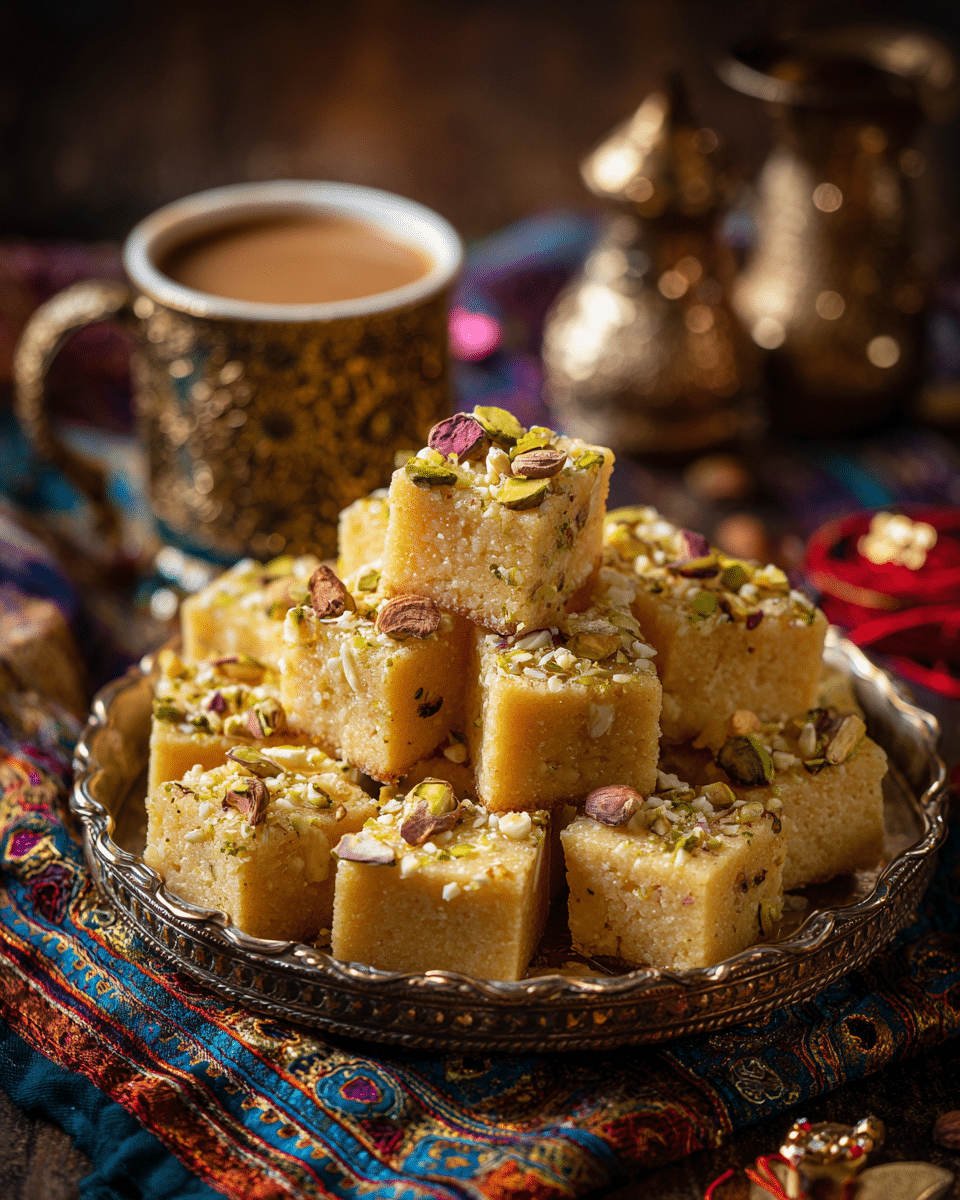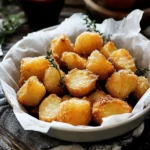Soan Papdi is a traditional Indian dessert known for its light, flaky texture and melt-in-the-mouth sweetness. Commonly enjoyed during festivals like Rakhi and Diwali, it is made with a combination of gram flour (besan), all-purpose flour (maida), ghee, sugar, and flavored with cardamom and nuts. Its unique texture comes from a technique that involves stretching sugar syrup into fine threads, similar to spun sugar, making it both a delightful treat and a festive showstopper.
FULL RECIPE
Ingredients
- 1 cup gram flour (besan)
- 1 cup all-purpose flour (maida)
- 1 cup ghee (clarified butter)
- 2 cups sugar
- ½ cup water
- 1 tablespoon milk (optional, for cleaning syrup)
- ½ teaspoon cardamom powder
- 2 tablespoons chopped pistachios
- 2 tablespoons chopped almonds
Directions
- Sift together gram flour and all-purpose flour in a bowl to remove any lumps.
- In a heavy-bottomed pan, heat ghee on low flame and add the flour mixture. Roast it slowly until it turns golden and aromatic. Set aside to cool slightly.
- In another pan, combine sugar and water to prepare the syrup. Boil until it reaches the hard-ball stage (around 240°F or 115°C). You can check by dropping a little syrup into cold water—it should form a firm but pliable ball.
- Add cardamom powder to the syrup and remove from heat. Let it sit for a few seconds to thicken slightly but not harden.
- Immediately pour the syrup into the roasted flour mixture and mix vigorously with a spatula or wooden spoon.
- As it begins to cool, stretch the mixture by pulling and folding repeatedly to develop fine threads. Work quickly while the mixture is warm.
- Press the stretched mixture into a greased square tray or dish and smooth the surface.
- Sprinkle chopped almonds and pistachios on top, pressing them in gently.
- Let it cool completely, then cut into square or diamond-shaped pieces.
- Store in an airtight container at room temperature.
Nutrition Facts
- Calories: 210
- Total Fat: 12 g
- Saturated Fat: 6 g
- Carbohydrates: 23 g
- Sugars: 18 g
- Protein: 2 g
- Dietary Fiber: 0.5 g
- Sodium: 5 mg
- Calcium: 10 mg
- Iron: 0.7 mg
Cultural Significance of Soan Papdi
Soan Papdi holds a cherished place in Indian culture, especially during festive occasions like Raksha Bandhan, Diwali, and Holi. It is often exchanged as a symbol of goodwill, love, and celebration. Its presence in festive sweet boxes makes it a familiar treat during religious ceremonies and family gatherings. Gifting Soan Papdi during Rakhi is more than just a tradition—it represents the sweetness of sibling bonds and the joy of shared memories. For many, receiving or preparing this flaky dessert evokes nostalgia and connects them to generations of culinary heritage.
Unique Texture and Technique
What sets Soan Papdi apart from other Indian sweets is its signature texture—light, flaky, and almost thread-like. This texture is achieved through a specialized technique that involves pulling and folding the dough as it cools, similar to making spun sugar. Unlike dense sweets such as barfi or laddoo, Soan Papdi’s airy consistency gives it a melt-in-the-mouth feel that appeals to all age groups. This technique, while requiring practice, makes the dessert stand out as a unique showpiece in Indian confectionery.
Flavor Profile and Aromatics
Soan Papdi offers a delicate flavor balanced between the richness of ghee and the sweetness of sugar, enhanced with the warm, slightly citrusy note of cardamom. The nut toppings, typically almonds and pistachios, introduce a subtle crunch and earthy contrast to the soft layers. For those who appreciate traditional Indian flavors, Soan Papdi provides a harmonious blend of textures and tastes that is both indulgent and refined. The fragrance of roasted flour and ghee lingers, adding to its sensory appeal.
Variations and Regional Twists
Though traditionally made with gram flour and sugar, Soan Papdi has evolved to include numerous regional and modern variations. Some recipes incorporate saffron strands for added luxury and color, while others use rose water or kewra for floral undertones. In certain regions of North India, especially in Punjab and Uttar Pradesh, you’ll find versions that are more brittle or chunkier in texture. Modern takes also include chocolate-dipped Soan Papdi or fusion flavors like mango, strawberry, or even paan, broadening its appeal beyond traditional palates.
Serving Suggestions and Presentation Ideas
Soan Papdi is best served at room temperature, where its texture and aroma are most pronounced. For an elegant presentation, you can place individual squares in mini cupcake liners or decorative trays during festivals or celebrations. Dusting the top with a light sprinkle of edible silver leaf (varak) adds a luxurious touch, making it perfect for festive platters. It pairs beautifully with a hot cup of chai, and its dainty size makes it a perfect post-meal treat during dinner parties or family feasts.
Ideal for Gifting and Celebrations
Thanks to its dry, non-perishable nature, Soan Papdi is a popular choice for gifting. It travels well, doesn’t require refrigeration, and maintains its texture for several days. Its festive packaging, often in colorful boxes or tin containers, makes it suitable for weddings, return gifts, and holiday hampers. Homemade Soan Papdi can be portioned into cellophane-wrapped pieces or stacked in gift jars to create personalized presents. The fact that it is both luxurious and traditional enhances its appeal as a thoughtful gift during auspicious events.
Storage Tips and Shelf Life
Proper storage is crucial for maintaining the freshness and texture of Soan Papdi. It should be kept in an airtight container at room temperature, away from humidity and direct sunlight. When stored correctly, it stays fresh for up to two weeks. Avoid refrigerating, as the moisture can cause the flakes to collapse and the sugar to crystallize, ruining its signature lightness. If making a large batch, consider using parchment paper between layers to prevent sticking and preserve its form.
Health Considerations and Moderation
While Soan Papdi is undeniably indulgent, it can be enjoyed in moderation as part of a balanced diet. The use of ghee, gram flour, and nuts offers some nutritional benefits such as healthy fats, protein, and iron. However, its high sugar content makes portion control important, especially for individuals managing diabetes or weight concerns. Healthier modifications, such as reducing sugar, using jaggery, or substituting part of the ghee with nut oils, can be explored for a lighter version without compromising too much on flavor.
Tips for Success When Making at Home
Achieving the perfect texture of Soan Papdi at home requires attention to detail and timing. The key lies in reaching the correct sugar syrup consistency—too thin, and it won’t set; too thick, and it becomes brittle. It’s also important to roast the flours thoroughly in ghee to eliminate the raw taste and develop a rich aroma. Working quickly when combining the syrup and flour is critical, as the mixture hardens fast. Using a greased surface and tools can help manage the sticky texture during the stretching and shaping process.
Advertisement
Pairing with Other Indian Sweets
Soan Papdi complements a wide variety of Indian sweets on a festive platter. It pairs well with rich, dense items like kaju katli or motichoor laddoo, providing a contrast in texture and flavor. When served alongside milk-based sweets like rasgulla or peda, it adds a dry, crunchy counterpoint. It can also be included in a mithai box assortment with regional treats like Mysore pak, sandesh, and coconut burfi to showcase a range of traditional confections at weddings or holiday events.
Conclusion
Soan Papdi is more than just a sweet—it’s a celebration of tradition, craftsmanship, and festive joy. Whether bought from a sweet shop or made at home, its delicate threads and rich flavor profile offer an unforgettable dessert experience. Its versatility in presentation, storage, and customization make it a staple in Indian festivities and an increasingly popular choice for modern dessert lovers. From honoring family traditions to sharing joy with friends, Soan Papdi is a delightful way to sweeten any occasion.






